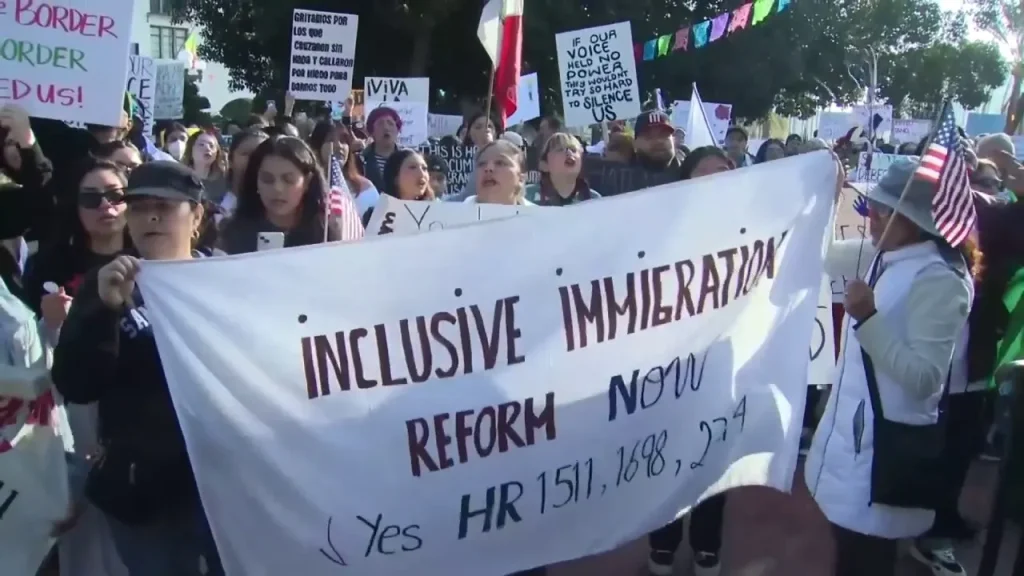The Los Angeles Police Department (LAPD) faced scrutiny following anti-ICE protests over the weekend, with its largest union, the Los Angeles Police Protective League (LAPPL), calling for an investigation into the handling of the demonstrations. The protests, sparked by the Trump administration’s immigration policies, drew thousands of participants and resulted in several LAPD officers sustaining injuries. The LAPPL expressed concern over what it perceived as a “communication breakdown” that led to a lack of arrests despite officers being attacked. They emphasized that arresting individuals assaulting police officers should be a straightforward decision for any competent incident commander and stressed the importance of holding those responsible for the violence accountable. The union also highlighted the negative impact on officer morale when violent actors are allowed to blend in with peaceful protesters.
The protests, held on Sunday and Monday, saw demonstrators taking to the streets and even blocking the 101 Freeway, a major artery in Los Angeles. Clashes between protesters and police occurred, with some demonstrators throwing objects at officers equipped with riot gear and non-lethal weapons. Although hundreds were initially detained, no arrests were made on Monday. LAPD Chief Jim McDonnell denied issuing a stand-down order, stating that the incident commander’s decisions prioritized public and officer safety. However, the on-site incident commander, Lillian Carranza, asserted that the gathering became an unlawful assembly the moment officers were assaulted. She did not clarify whether she had instructed officers to refrain from making arrests.
The LAPPL disputed the Chief’s claim, alleging that the incident commander, not the Chief, issued the stand-down directive, thereby endangering officers. They called for an investigation to pinpoint the communication breakdown and establish protocols to ensure the safety of both peaceful protesters and officers, while also holding violent individuals accountable. A source familiar with the situation corroborated the LAPPL’s account, describing the frustration and confusion among officers due to the unclear directives. The LAPPL emphasized the need to strike a balance between protecting the right to peaceful protest and ensuring officer safety while addressing violent actions.
The LAPD’s “control objectives,” as outlined by Carranza, included maintaining a visible, crowd-friendly law enforcement presence, ensuring safe arrival and departure for participants, and protecting life, property, and facilities. Taking action against law violators was also listed among the objectives. The LAPPL, however, argued that the execution of these objectives was compromised by the alleged stand-down order, leading to officers being subjected to violence without the ability to make arrests. This discrepancy between stated objectives and the reality on the ground further underscores the need for a thorough investigation, according to the union.
The protests highlighted a range of opinions on immigration policy. Demonstrators carried signs with messages such as “No human is illegal on stolen land” and “Fight ignorance, not immigrants.” Some protesters were seen spraying graffiti on freeway walls and vandalizing a car trapped amidst the crowd, as depicted in videos circulating on social media. These acts of vandalism added another layer of complexity to the situation, raising questions about the extent of property damage and the measures taken to prevent such acts during the protests.
The backdrop to these protests is the Trump administration’s intensified crackdown on illegal immigration, with ICE reporting over 7,400 arrests and nearly 6,000 detainers in nine days. This context further fuels the tension surrounding the protests and underscores the conflicting perspectives on immigration enforcement. While the LAPPL focuses on officer safety and accountability for violence, the protesters express their dissent against the administration’s immigration policies. This clash of priorities necessitates a careful examination of the events and a balanced approach to addressing the concerns of all involved parties. The LAPD’s response and the subsequent investigation will likely have implications for future protests and the delicate balance between upholding free speech and maintaining public order.

